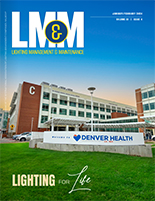| Shepherdstown, WV, November 26, 2018 – “Everything you’ve ever wanted to know about wired and wireless control protocols for residential and nonresidential lighting” might just as well be the title of a fascinating, new panel discussion that considers new and emerging lighting-control technologies in use around the world. The panel was assembled for the seventh Annual Lighting Forum sponsored by the National Lighting Bureau (NLB)and cosponsored by the EdisonReport and the International Brotherhood of Electrical Workers. Panelists were James M. “Jim” Yorgey, PE, LC, formerly technical-applications manager at Lutron Electronics Company, and now a consultant in the field, and Doyle Young, previously the North American sales manager for Casambi Technologies.
Mr. Yorgey provided a thorough overview of wired protocols, including analog systems that use line-voltage and low-voltage wiring. He also covered systems that rely on the Digital Addressable Lighting Interface (DALI) protocol that provides a single interface for all electronic-control gear and devices; DMX systems, created for theatrical use; and power over the ethernet, or POE, that transmits data and power in a single, ethernet-type cable. Although it’s easy to understand why analog systems might be on the decline, that actually is not the case, Mr. Yorgey said. In fact, new standards for analog, wired systems are in development, driven partially by the U.S. military and government requirements for wired systems. He also commented that, with respect to wired systems, the DALI protocol is more popular in Europe, but adoption in the U.S. is growing.
Mr. Young commented that wireless systems are growing rapidly, in large part because consumers are expecting them to work “no matter what.” But that’s not always the case. In an area like southern Florida, for example, concrete is used extensively to construct hurricane-resistant buildings and concrete can quickly absorb the radio waves wireless protocols rely on. And when wireless control units are installed inside luminaires, they tend to be surrounded by metal, which can significantly limit radio-wave propagation.
Bluetooth mesh is likely to be the protocol of the future, Mr. Young said, because it permits simple Internet of things (IoT) integration, enabling many devices to speak with many other devices, but not just for lighting; also for transmitting data of different types, like weather data about humidity levels, temperatures, wind speed, and wind direction. He added that Bluetooth consumes little energy, is already in millions of smart phones and smart devices, and is far more secure than most people realize; while hackers can get into Bluetooth, they can’t use it as a gateway to other parts of a network.
The complete video is available for viewing free of charge at the National Lighting Bureau website: https://nlb.org/protocols-for-wired-and-wireless-systems-video/.
The National Lighting Bureau is an independent, IRS-recognized educational foundation that has served as a trusted lighting-information source since 1976. The Bureau is able to provide its services to the public free of charge because of the generous funding of the organization’s sponsors: professional societies, trade associations, labor unions, manufacturers, service providers, and agencies of the U.S. government, including:
· BIOS Lighting;
· Current, Powered by GE;
· Forest Lighting;
· Illuminating Engineering Society (IES);
· Imperial Lighting Maintenance Company;
· interNational Association of Lighting Management Companies (NALMCO);
· International Brotherhood of Electrical Workers (IBEW);
· Lighting Controls Association (LCA);
· LumenOptix;
· Lutron Electronics Company, Inc.;
· Luxtech;
· National Electrical Contractors Association (NECA);
· National Electrical Manufacturers Association (NEMA);
· OSRAM;
· U.S. General Services Administration; and
· ZLED Lighting.
Obtain more information about the Bureau by visiting its website (https://www.nlb.org/) or by contacting its staff at [email protected]. Information about sponsorship also is available there. |


